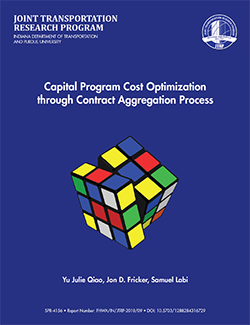Bundling similar bridge or highway projects can produce cost savings due to economies of scale. Repeatable details and similar designs can save both design and construction time, and grouping multiple projects into one contract can lower the unit cost for materials, resulting in a lower cost per project. To achieve these benefits, agencies must decide which projects are most cost effective to bundle and how large the bundle should be - large enough to achieve economies of scale but not so large that few contractors can bid on it, since maximizing the number of bidders can also lower cost.
The Indiana Department of Transportation (INDOT) examined the effects of contract size and other factors on the cost savings that can be achieved by bundling. Researchers used 9 years of data from 1,997 bridge projects delivered via 715 INDOT contracts. The results confirmed and documented the benefits of bundling and produced models INDOT can use to select the most appropriate projects to bundle in the future.
The INDOT study investigated several factors affecting project bundling costs, including project size, bundle size, bidding market conditions, and the degree to which bundled projects were similar.
The following is an abridged version of the researchers' findings.
ECONOMIES OF SCALE
A decline in unit costs as project size increased was documented for all project types analyzed. This was true for both single- and multiple-project contracts.
ECONOMIES OF BUNDLING
A reduction in cost per project as bundle size grew was found for all bridge project types and for most traffic, small structure, and miscellaneous project types. However, for road project types, a reduction in project cost due to bundling was found for four certain types of road projects, but not others. The conclusion was that similar road work project types can benefit from bundling.

ECONOMIES OF COMPETITION
Having more bidders lowers costs for most bridge projects, but larger contracts can discourage small firms from bidding. This can lead to less competition and, therefore, higher unit costs. Researchers modeled the relationship between market competition and contract size using both deterministic and probabilistic methods. According to the probabilistic model, the average number of bidders tends to be highest when two to four projects are bundled.
PROJECT SIMILARITY
The degree to which projects within a bundle are similar was identified as an important factor for reducing project cost, especially for road work. Researchers measured project similarity using statistical models based on the pay items included in the contract. They verified that project types in the same work category are better candidates for bundling compared to projects in different work categories.
MAINTENANCE OF TRAFFIC (MOT) COST
MOT can be a major component of project cost. The study found that project bundling could generally reduce MOT cost for most road, traffic, bridge, and small structure work types. Of all work categories, road work was found to benefit the most from project bundling in terms of MOT cost savings.
INDOT's past project bundles were frequently based on combinations of work categories, such as bridges with road work, traffic with road work, bridges with traffic and road work, and bridges with small structures work. Commonly combined project types included intersection improvements with traffic signals, new bridges with new road construction, and bridge replacement with bridge deck overlay.
The study's recommendations for future bundling strategies included using the statistical models developed to identify projects most suitable for combining into multiple-project contracts. In addition, patterns found in the study can be used to guide the number of projects selected for multiple-project bundles.
The findings can also be used as a guide to support project scheduling decisions. For example, a certain collection of individual projects may yield significant cost savings for INDOT, but the locations of the projects may create unacceptable disruptions in traffic.
INDOT has developed business rules for bundling more strategically during early project programming. This institutionalizes a process to allow for greater economies of scale throughout project delivery. As INDOT bundles more projects, the related databases will continue to grow, as well as evidence concerning which bundles saved money and which did not.
Qiao, Y. J., Fricker, J. D., & Labi, S. (2018). Capital Program Cost Optimization through Contract Aggregation Process (Joint Transportation Research Program Publication No. FHWA/IN/JTRP-2018/09). West Lafayette, IN: Purdue University. https://doi.org/10.5703/1288284316729
FHWA Bridge Bundling Guidebook https://www.fhwa.dot.gov/ipd/pdfs/alternative_project_delivery/bridge_bundling_guidebook_070219.pdf
FHWA Every Day Counts Project Bundling https://www.fhwa.dot.gov/innovation/everydaycounts/edc_5/project_bundling.cfm